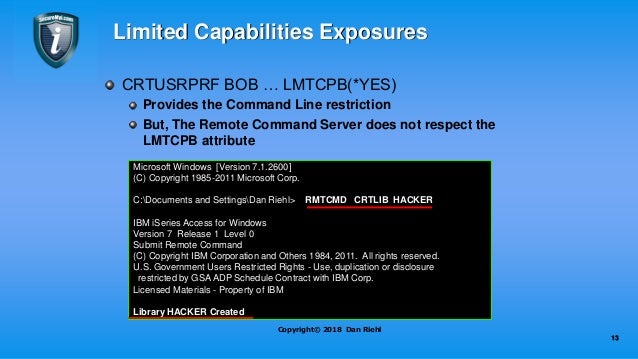

- Rmtcmd.exe ibm i access client solutions install#
- Rmtcmd.exe ibm i access client solutions 32 bit#
- Rmtcmd.exe ibm i access client solutions full#
- Rmtcmd.exe ibm i access client solutions Pc#
Rmtcmd.exe ibm i access client solutions Pc#
Using the RUNRMTCMD command on a PC connected with SNA may fail with PWS000D (for CISC) or withĬPF91CC (on a RISC) if QSYS2 is not part of the library list. RUNRMTCMD Fails with MCH3401 Cannot Resolve to Object CMINIT
Rmtcmd.exe ibm i access client solutions full#
See the full command line with arguments in Section 4.Subfunctional Area: Incoming Remote Command/Remote Command You may want to automate the part that starts IBM i Access Client Solutions correctly, in the workflow, before attaching it with the Terminals Session Activity. We’ll proceed with the first, Standard HLL API, so we add a Terminal Session Activity in a Workflow in UiPath Studio and configure it as follows:

Pcshll32 - is the Enhanced HLL API interface
Rmtcmd.exe ibm i access client solutions install#
This pretty much follows normal EHLLAPI procedure, but the DLL chosen has to be one from the EHLLAPI Bridge location, see section 3.2 above, and here is the default install location as well:ĮHLAPI32.dll - is the Standard HLL API interface above) and a 5250 session was established. Connect to IBM i Access Client Solutions from UiPath Studioįirst, make sure IBM i Access Client Solution is running (see Section 4. NOTE: Alternately, you can see IBM’s recommendations on this on it’s website: 5. vm "C:\Program Files (x86)\Java\jre1.8.0_181 " - this argument is one more safety measure to enforce that Access Client Solutions starts with a 32-bit Java Runtime Environment for sure (the path you give within quotes has to be valid on your machine and a true 32-bit Java Runtime must reside there)Īlso start Access Client Solutions 32-bit from your desktop (it’s normally this icon : ). PLUGIN=PCS - it’s a parameter that tells Access Client Solutions to turn the Programmable Interface on, in some cases this might be needed, so to be on the safe side start it anyway. "C:\Users\cornel.dumitrascu\IBM\ClientSolutions\Start_Programs\Windows_i386-32\ acslaunch_win-32.exe " /PLUGIN=PCS -vm "C:\Program Files (x86)\Java\jre1.8.0_181 "Īcslaunch_win-32.exe - ensures we are running Access Client Solutions 32-bit The best way to make sure everything starts smoothly is from command line: Starting IBM i Access Client Solution with the EHLL API bridge Make sure the location is valid and that it contains the EHLL DLLs, similar to this (the libraries of interest for us marked in yellow):Ĥ. The EHLL API Bridge only comes in 32-bit format and should get installed by default under " * c:\Program Files (x86)\IBM\EHLLAPI* "
Rmtcmd.exe ibm i access client solutions 32 bit#
The set to a Java Runtime Environment from within C:\Program Files (x86) means it’s the 32 bit version. If you need to validate the correct version when it’s started, press Help → About, and you should see the following (important items highlighted in yellow): You will need to use the Access Client Solutions’ 32-bit launcher, it’s called acslaunch_win-32.exe and it is located, in my case, under c:\Users\cornel.dumitrascu * \IBM\ClientSolutions\Start_Programs\Windows_i386-32* Note that the general principle here is 32-bit. Here’s a screenshot with the necessary IBM downloads highlighted:

The trick is it will need the programmable interface to be enabled and the EHLL Bridge installed. If that is not an option, I’ll leave here a rather long step-by-step guide for iACS v1r1. If you can get an IP Address/Port for the mainframe backend, I would recommend to go with Direct Connection as this will remove a lot from the complexity. I understand this is about IBM iACS ( i Access Client Solutions).


 0 kommentar(er)
0 kommentar(er)
